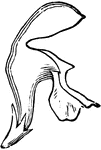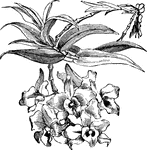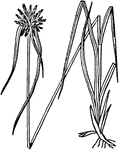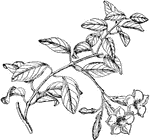277 illustrations of flowers and shrubs including: daffodil, dahlia, daisy, dandelion, darlingtonia, datura, dayflower, devil's claw, dewberry, dill, dittany, dodder, dogbane, dogwood, doveweed, dutchman's pipe, elder, erianthus, and eyebright
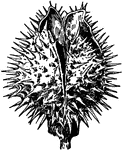
Datura Fruit
"Fruits adapted for dispersal by the shaking action of the wind: jimson weed (Datura)." -Bergen, 1896
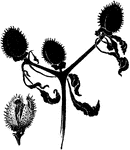
Datura Stramonium
Illustrated are pods of datura stramonium. The common name is thorn apple or Jamestown weed.
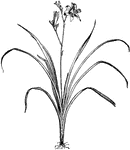
Day Lily (Hemerocallis Fulva)
Day lily is the common name of hemerocallis. The fulva variety has large flowers, about four inches…
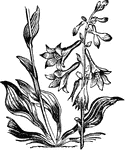
Day-lily
"A genus of plants of the natural order Liliaceae, having a perianth with bell-shaped limb, and sub-cylindrical…

Yellow Day-lily
Hemerocallis lilioasphodelus, (syn. Hemerocallis flava, Lemon Day-lily Lemon Lily, Yellow Day-lily)…

Deadly Nightshade
A flowering branch. 1, flower after removal of the corolla; 2, corolla, with stamens cut open and flattened;…

Delphinium Ajacis
Delphinium ajacis grows about eighteen inches tall. The flowers are showy and blue or violet. The flowers…

Delphinium Formosum
Delphinium formosum has a strong stem that grows two to three feet tall. The flowers are blue with indigo…
Follicle of Delphinium
A follicle is a kind of fruit consisting of a single carpel, opening at the lower part where the pistils…
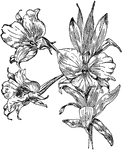
Dendrobium Dearei
Dendrobium dearei has white flowers that are about two inches across. The plant is native to the Philippines.
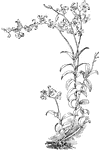
Dendrobium Superbiens
Dendrobium superbiens is native to Australia. The flowers are two inches across and crimson-purple.…

Dentaria Diphylla
The common name of dentaria diphylla is pepper root. The plant grows eight to sixteen inches tall. The…
Pteris Denticulata
A slightly-toothed fern with fronds ranging between 1 foot and 2 feet in length. It is a long and slender…

Desmodium Canadense
Illustrated are the pods of desmodium canadense. The plant is also known as tick trefoil.
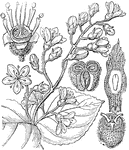
Deutzia
"Deutzia crenata. 1. a flower with the petals removed; 2. a fruit; 3. a portion of the same, showing…
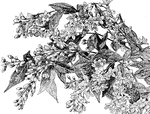
Deutzia Gracilis
Deutzia gracilis grows three feet tall and has slender, arching branches. The flowers are pure white.…
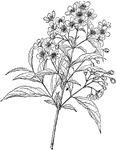
Deutzia Lemoinei
Deutzia lemoinei grows three feet tall. The flowers are pure white. The leaves have finely serrated…
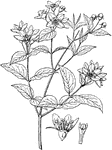
Deutzia Purpurascens
The deutzia purpurascens shrub grows three feet tall with slender, arching branches. The flowers have…
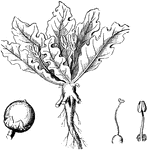
Devil's Apples
Devil's Apples is the common name of mandragora vernalis. The flowers are white or bluish. Pictured…
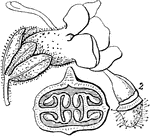
Devil's Claw
"Martynia lutea. 1. a flower; 2. the pistil; 3. a section of its ovary." -Lindley, 1853

Dewberry
"A plant of the same genus with the Bramble, and very nearly allied to it, but having weaker and more…
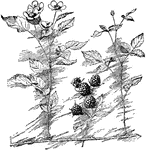
Lucretia Dewberry
In true dewberries the center flowers open first. The flowers and fruits are few and scattereed.
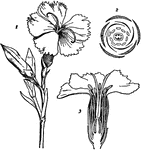
Dianthus
Dianthus is a genus of about 300 species of flowering plants in the family Caryophyllaceae, native mainly…

Dianthus Chinensis
Dianthus chinensis flowers are large, clustered, and pink or lilac. The plant is native to China and…

Dianthus Superbus
Dianthus Superbus is found from Norway to Japan and Spain. The flowers are lilac and very fragrant.
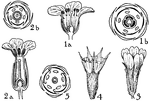
Orders of Diapensiaceae, Primulaceae, and Plumbaginaceae
Pictured are flowers of the orders diapensiaceae, primulaceae, and plumbaginaceae. The flowers of these…

Diascia Barberae
Diascia barberae blooms freely in the summer. The flowers are rose pink with a yellow, green dotted…
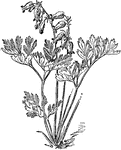
Dicentra Formosa
Dicentra formosa is native from central California to British Columbia. The flowers are rose purple…

Dicotyledonous Morphology
"Morphology of a typical dicotyledonous plant. A, leaf, pinnately-netted veined; B, portion of stem,…
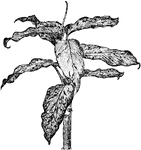
Dieffenbachia Picta Bausei
Dieffenbachia picta bausei has a blade that is nearly or completely yellowish green. It also has obscurely…
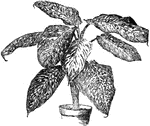
Dieffenbachia Seguine Nobilis
Dieffenbachia seguine nobilis is native to Brazil. The blade is dull green with dirty green spots.
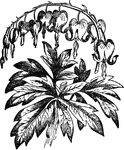
Dielytra
"A genus of plants of the natural order Fumariaceae, in appearance and habit much resembling fumitories…
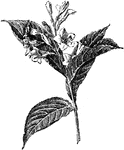
Diervilla Hybrida
Diervilla hybrida is used as a collective name for the various hybrids of the diervilla species.
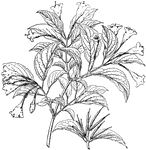
Diervilla Japonica
Diervilla japonica is native to Japan and China. It blooms in May and June. The flowers usually grow…

D. Rotundifolia Digestive Gland
"Longitudinal section through a digestive gland of Drosera rotundifolia." -Stevens, 1916
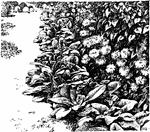
Digitalis Purpurea
The common name of digitalis purpurea is common foxglove. Illustrated is the juvenile or foliage stage…

Digitalis Purpurea
Foxglove is the common name of digitalis purpurea. It is native from Great Britain, west and central…
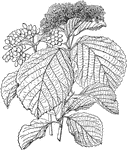
Viburnum Dilatatum
Perennial featuring flat topped flowers, bearing different color flowers depending on the seasons. Typical…
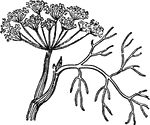
Dill
Dill (Anethum graveolens) is a short-lived perennial herb. It is the sole species of the genus Anethum,…
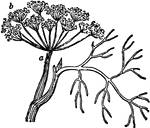
Dill
Dill (Anethum graveolens) is a short-lived perennial herb. It is the sole species of the genus Anethum,…

Dimorphotheca Aurantiaca
Dimorphotheca aurantiaca is a variety of cape marigold. The flowers are large and orange yellow. It…
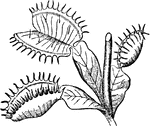
Dionaea
"A very curious and interesting genus of plants of the natural order Droseraceae, having a 5-partite…

Dioscorea Alata
Illustrated is the foliage and a small tuber of dioscorea alata. The leaves are oblong and heart shaped.…

Diphylleia Cymosa
This illustration shows the rhizoma of Diphylleia cymosa, showing six years of growth, and a bud for…
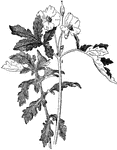
Stylophorum Diphyllum
This perennial herb is common to many woodlands of the eastern parts of the US, these plants feature…

Dipladenia Splendens
Dipladenia splendens is native to Brazil. The flower clusters have four to six flowers.



